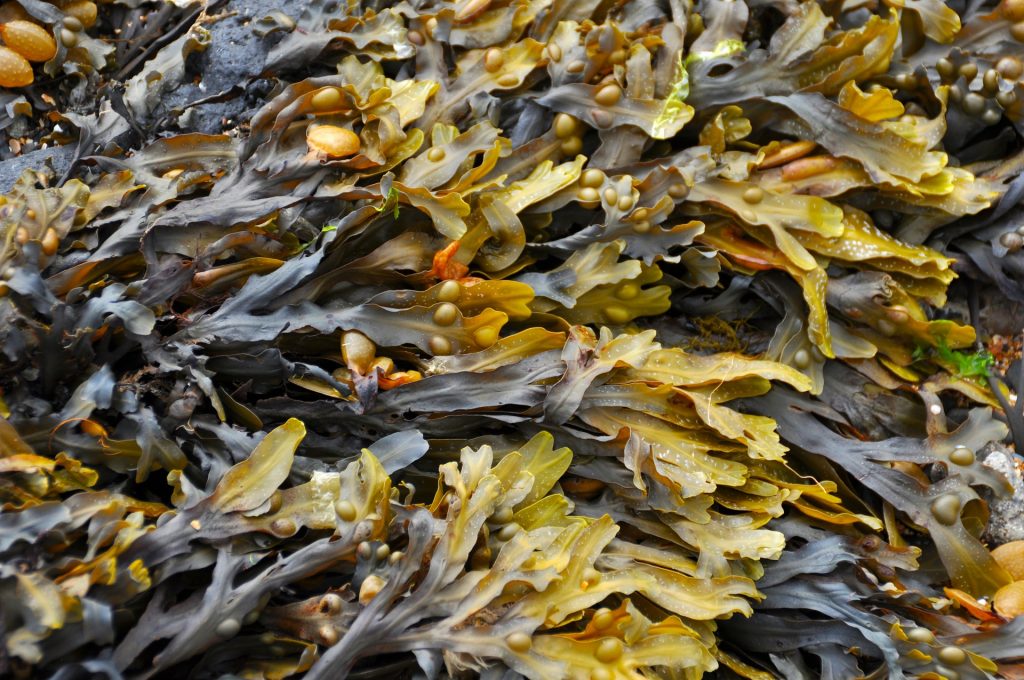
They have no root, no stem, no flower or fruit, and live in seas, rivers, or lakes. They are true aquatic jewelry, in particular, the marine algae. Algae are the food base of the aquatic ecosystem, but also provide nutritional, medicinal and environmental, exceptional benefits for humans. It is no coincidence that many peoples living along the coast, particularly those in Southeast Asia, the Indians of Latin America, or the Europeans, especially in the North, have been the ones who consume regularly for many thousands of years.
In Portugal, the algae harvest was first regulated in 1308 by King D. Dinis. Even today the Sargassum Muticum, commonly known as Japanese wireweed, is often extracted for the production of biofertilizer.
The algae are unique beings that are distinguished by their lively and varied palette of colors. There are more than 25 thousand species classified according to the composition of their pigmentation, the color, which ranges from green to brown, passing through red to blue. But be aware that not all of them can be consumed by humans, because they are toxic (they have a very high energy frequency that is not compatible with our current state) and consumption must always be on 100% biological algae.
These aquatic vegetables are seen by many experts as a gift of the future due to the ease and speed with which they grow and adapt to the environment, which allows a constant natural reproduction or even a large scale production in aquaculture and at a “low cost”.
The 2013 data published by the Food and Agriculture Organization of the United Nations (FAO) already showed that around 27 million tonnes of algae are produced annually worldwide, 90% of which is made in aquaculture. In financial terms, it is worth about seven billion dollars, according to FAO.
These are, however, very modest numbers in view of the great potential that exists: production for human consumption and for the chemical industry which, in addition to manufacturing medicines and beauty products, also bet on the creation of the new generation of plastics, bioplastics. This may even be one of the solutions to curb the wave of pollution that is killing the planet, according to the latest data released by the United Nations (UN) 400 million tons of plastic are produced annually, of which only 9% are effectively recycled.
Nowadays, according to a study by the Ellen MacArthur Foundation, unveiled at the Davos Economic Forum in 2016, for every five tonnes of fish there is one tonne of plastic at sea. A ratio that in 2025 could be changed from just three tons of fish to one of garbage (read more in “Recognize a plastic with bisphenol a and protect your life“).
To fight this giant wave, there are already companies such as Iberagar, Algaplus, Wedotch or Algatec, among others that operate in Portugal, which develop the macroalgae for the production of bioplastics (in addition to producing algae for food and the industry). It is the answer to the demands of Brussels that intends, by 2020, to have 10% of bioplastics created in the European market.

Marine algae radiate nutrients
If you have ever eaten in a Chinese, Japanese, Thai or macrobiotic restaurant, you’ve probably tasted algae, even without knowing it. These sea vegetables, we will focus the analysis only on the macroalgae of the sea, are rich in:
- in carbohydrates,
- proteins,
- calcium,
- vitamins and
- essential minerals
They are sources of iodine, iron, potassium, copper, magnesium, and zinc, among other nutrients, many algae also contain carotene, a substance that has a protective role against cancer cells. But for algae to have high nutritional values it is necessary that it be grown in its natural habitat and harvested in deep, unpolluted oceans and processed by traditional methods, experts say. It should be noted, however, that algae are environmental bioaccumulators, that is, their tissues can accumulate heavy metals such as mercury, lead, tin, among others, as a result of the pollution of the oceans. But despite the risk, they have a unique nutritional value.
Pedro Lôbo do Vale, a physician, quoted on the Granary website, said: “Algae have a high protein content and some species, such as Spirulina, contain about 70% protein. They are rich in essential amino acids and very well digested due to the presence of minerals and some enzymes. These vegetables have a low level of carbohydrates and sugars. “This doctor also explains that algae iodine can help balance thyroid dysfunction in case of hypothyroidism, however, for this type of patients, Pedro Lôbo do Vale says the doctor’s advice is essential for anyone who wants to eat a regular algae-based diet.

The menu of benefits to the human body is very vast, but only to have an idea they strengthen the immune system, cleanse and detoxify the blood and body, so they are often recommended in treatments against obesity. And protect the heart or stomach from gastritis and ulcers, among many other situations, in addition to hair and skin beauty treatments.
But before consuming you should be aware that each seaweed has unique benefits that should be respected, for example, if it is saltwater and if it is more adjusted for times of higher temperatures (spring or summer) or cold as autumn or winter. Questions that can be answered by a nutrition expert.
This text is an awareness. According to the season of the year and the moment in which you are, it is up to each one to feel if he should consume this food. The dosage and frequency depend on the nature and physical condition of each Human Being.
Feel more about algae in:
10 kinds of algae to have at table




